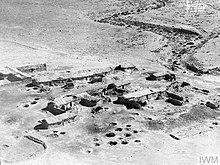| Simele massacre | |
|---|---|
 Aerial view of Batarshah in northern Iraq, an Assyrian village destroyed by Arabs and Kurds in August 1933 | |
 Area where villages were looted
Heavily targeted Assyrian villages | |
| Native name | مذبحة سميل (Arabic)[1] ܦܪܲܡܬܵܐ ܕܣܸܡܹܠܹܐ (Syriac)[2][3] |
| Location | Northern Kingdom of Iraq, notably at Simele |
| Coordinates | 36°51′30″N 42°51′0.35″E / 36.85833°N 42.8500972°E |
| Date | 7 August 1933 – 11 August 1933 |
Attack type | Summary executions, mass murder, looting |
| Deaths | Several hundred (British estimate)[4][5][6] 3,000–6,000 (Assyrian estimate) |
| Victim | Assyrians |
| Perpetrators | Royal Iraqi Army (led by Bakr Sidqi, Arab and Kurdish tribes[7] |
| Motive | Anti-Christian sentiment |
The Simele massacre (Arabic: مذبحة سميل, romanized: maḏbaḥat Simīl), also known as the Assyrian affair,[8] was committed by the Kingdom of Iraq, led by Bakr Sidqi, during a campaign systematically targeting the Assyrians in and around Simele in August 1933.
The number of deaths was estimated by British officials at 600.[5] Some Assyrian estimates are higher, positing that as many as 6,000 were killed and over 100 Assyrian villages were destroyed and looted.[9][10]
- ^ "عضوة الكونغرس الامريكي جان شاكوسكي تصدر بيانا في ذكرى مذبحة سميل التي تعرض لها شعبنا عام 1933". Zowaa (in Arabic). 8 August 2020. Retrieved 19 December 2020.
- ^ "Sapra Suryaya" (PDF).
- ^ "Search Entry". assyrianlanguages.org. Retrieved 19 December 2020.
- ^ Sykes, Percy (1934). "A summary of the history of the Assyrians in 'Iraq, 1918–1933". Journal of the Royal Central Asian Society. 21 (2): 255–268. doi:10.1080/03068373408725306. "At other villages batches of men were killed, the total number aggregating 550."
- ^ a b Zubaida 2000: "The total number of Assyrian victims of these events was estimated by British officials at about 600, but Assyrian sources put it at several thousand."
- ^ Llewellyn-Jones, Rosie (2019). "The Assyrians in World War One and the 1933 Massacre: New Discoveries in the Rsaa Archives". Asian Affairs. 50 (4): 569–587. doi:10.1080/03068374.2019.1672427. S2CID 211652462. "Nearly 1,000 men, women and children were killed by Iraqi armed forces – and their villages were looted by Kurdish tribesmen."
- ^ Cite error: The named reference
Stafford168was invoked but never defined (see the help page). - ^ Levene 1999, p. 3.
- ^ Benjamen, Alda (2022). Assyrians in Modern Iraq: Negotiating Political and Cultural Space. Cambridge: Cambridge University Press. p. 17. ISBN 978-1-108-83879-5.
- ^ Donabed, Sargon (2010). Iraq and the Assyrian Unimagining: Illuminating Scaled Suffering and a Hierarchy of Genocide from Simele to Anfal. University of Toronto. pp. 69–72.